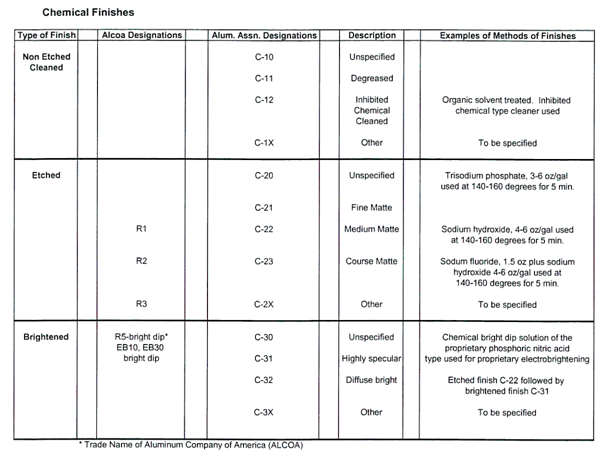Anodizing
Due to a large demand within your marketplace for technical information in regard to chemical finishing processes for aluminum extrusions, Alexandria Industries would like to take this opportunity to provide you with up to date information on the effects that chemical finishing can have on your products.
The most commonly used types of chemical finishing are: paint, chromate, hardcoat, electroless nickel, and anodizing. The type of chemical finishing process you select can play a very critical role in the cosmetic finish of your product. To achieve the final look that you desire, please consider the following factors as you design new parts for your customers.
Anodizing Process
Anodizing is one of the most common and durable chemical finishes. It uses direct current in an electro-chemical process to form a resilient, porous oxide film on the aluminum surface. Aluminum anodizing is an effective means of protecting aluminum alloys from atmospheric attack. When exposed to the atmosphere, untreated aluminum naturally forms a clear oxide layer that offers a high degree of universal protection. Common products requiring the anodizing processes include building products, appliances, food preparation equipment, home and office furniture, sporting goods, electronics, marine and recreation products, durable medical and electromedical components.
Etching and bright dipping are two universal preparatory steps used before the anodizing process.
Etching Process
A silver-white surface often called frosted, satin or matte is achieved in the etching process through the application of a hot caustic solution bath that removes alloy constituents and impurities. The next steps include a rinse and a deoxidize-desmut bath to eliminate imperfections on the surface. Etching breaks up the surface uniformly resulting in a more consistent finish as well as one that reduces some of the glare and reflectivity. Almost all anodized product will get some length of etch. The length of time in the etch bath will determine the amount and the aggressiveness of the etch itself; the longer the time, the more imperfections that are removed resulting in a greater matte finish.
Almost everything that is anodized will be etched first. If the product is intended to have some sort of improved aesthetic value it will go through the etching process before anodizing. Common products include flagpoles, medical device products, durable medical equipment, and light sensing equipment. Etching wouldn't be necessary if the anodic coating were applied for protection only and not for aesthetic improvement.

Bright Dip Process
To achieve a mirror finish a special dip solution or bright dipping acidic solution is used to remove the metal. The aluminum may be mechanically finished first to eliminate slight abrasions. To protect the smooth surface and to present a variety of colors, anodizing usually follows bright dipping. Alloy selection is very important to achieve the desired surface brightness and color clarity. Bright dip is a form of acid etching that causes the product to be very reflective. Common products requiring this bright dipped anodized surface include decorative trims, light frames, shower doors and reflectors.
The above image is a chemical finishing reference guide for anodic coating designations that will help illustrate the variation in these applications along with the different methods of finishes.
If you have immediate questions on chemical finishing processes, please contact your sales specialist and they will explain these topics in depth with you at any time.
